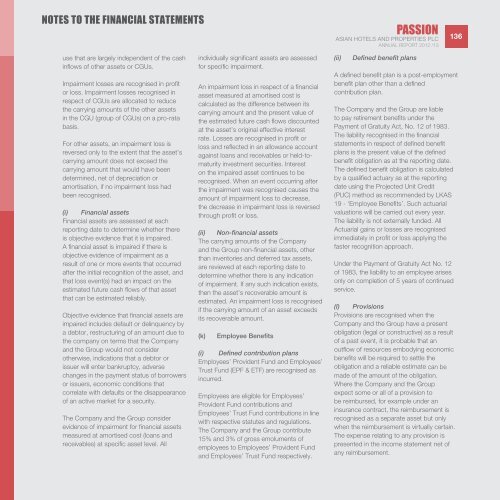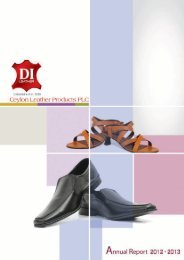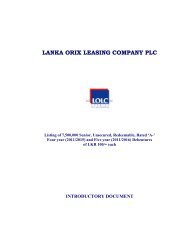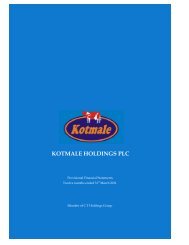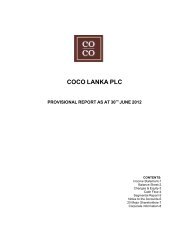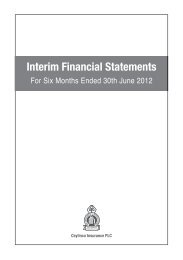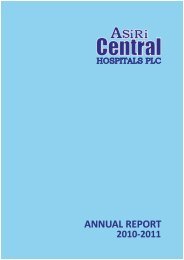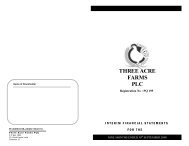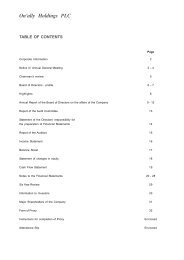ASIAN HOTELS AND PROPERTIES PLC AnnuAl RepoRt 2012/13
ASIAN HOTELS AND PROPERTIES PLC AnnuAl RepoRt 2012/13
ASIAN HOTELS AND PROPERTIES PLC AnnuAl RepoRt 2012/13
Create successful ePaper yourself
Turn your PDF publications into a flip-book with our unique Google optimized e-Paper software.
notes to the financial statementsPASSION<strong>ASIAN</strong> <strong>HOTELS</strong> <strong>AND</strong> <strong>PROPERTIES</strong> <strong>PLC</strong>Annual Report <strong>2012</strong> /<strong>13</strong><strong>13</strong>6use that are largely independent of the cashinflows of other assets or CGUs.Impairment losses are recognised in profitor loss. Impairment losses recognised inrespect of CGUs are allocated to reducethe carrying amounts of the other assetsin the CGU (group of CGUs) on a pro-ratabasis.For other assets, an impairment loss isreversed only to the extent that the asset’scarrying amount does not exceed thecarrying amount that would have beendetermined, net of depreciation oramortisation, if no impairment loss hadbeen recognised.(i) Financial assetsFinancial assets are assessed at eachreporting date to determine whether thereis objective evidence that it is impaired.A financial asset is impaired if there isobjective evidence of impairment as aresult of one or more events that occurredafter the initial recognition of the asset, andthat loss event(s) had an impact on theestimated future cash flows of that assetthat can be estimated reliably.Objective evidence that financial assets areimpaired includes default or delinquency bya debtor, restructuring of an amount due tothe company on terms that the Companyand the Group would not considerotherwise, indications that a debtor orissuer will enter bankruptcy, adversechanges in the payment status of borrowersor issuers, economic conditions thatcorrelate with defaults or the disappearanceof an active market for a security.The Company and the Group considerevidence of impairment for financial assetsmeasured at amortised cost (loans andreceivables) at specific asset level. Allindividually significant assets are assessedfor specific impairment.An impairment loss in respect of a financialasset measured at amortised cost iscalculated as the difference between itscarrying amount and the present value ofthe estimated future cash flows discountedat the asset’s original effective interestrate. Losses are recognised in profit orloss and reflected in an allowance accountagainst loans and receivables or held-tomaturityinvestment securities. Intereston the impaired asset continues to berecognised. When an event occurring afterthe impairment was recognised causes theamount of impairment loss to decrease,the decrease in impairment loss is reversedthrough profit or loss.(ii) Non-financial assetsThe carrying amounts of the Companyand the Group non-financial assets, otherthan inventories and deferred tax assets,are reviewed at each reporting date todetermine whether there is any indicationof impairment. If any such indication exists,then the asset’s recoverable amount isestimated. An impairment loss is recognisedif the carrying amount of an asset exceedsits recoverable amount.(k)Employee Benefits(i) Defined contribution plansEmployees’ Provident Fund and Employees’Trust Fund (EPF & ETF) are recognised asincurred.Employees are eligible for Employees’Provident Fund contributions andEmployees’ Trust Fund contributions in linewith respective statutes and regulations.The Company and the Group contribute15% and 3% of gross emoluments ofemployees to Employees’ Provident Fundand Employees’ Trust Fund respectively.(ii)Defined benefit plansA defined benefit plan is a post-employmentbenefit plan other than a definedcontribution plan.The Company and the Group are liableto pay retirement benefits under thePayment of Gratuity Act, No. 12 of 1983.The liability recognised in the financialstatements in respect of defined benefitplans is the present value of the definedbenefit obligation as at the reporting date.The defined benefit obligation is calculatedby a qualified actuary as at the reportingdate using the Projected Unit Credit(PUC) method as recommended by LKAS19 - ‘Employee Benefits’. Such actuarialvaluations will be carried out every year.The liability is not externally funded. AllActuarial gains or losses are recognisedimmediately in profit or loss applying thefaster recognition approach.Under the Payment of Gratuity Act No. 12of 1983, the liability to an employee arisesonly on completion of 5 years of continuedservice.(l) ProvisionsProvisions are recognised when theCompany and the Group have a presentobligation (legal or constructive) as a resultof a past event, it is probable that anoutflow of resources embodying economicbenefits will be required to settle theobligation and a reliable estimate can bemade of the amount of the obligation.Where the Company and the Groupexpect some or all of a provision tobe reimbursed, for example under aninsurance contract, the reimbursement isrecognised as a separate asset but onlywhen the reimbursement is virtually certain.The expense relating to any provision ispresented in the income statement net ofany reimbursement.


